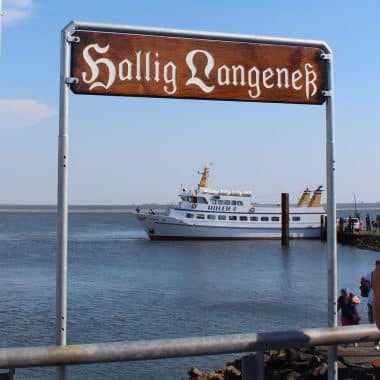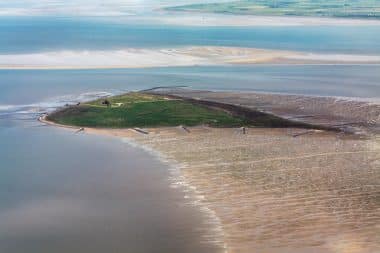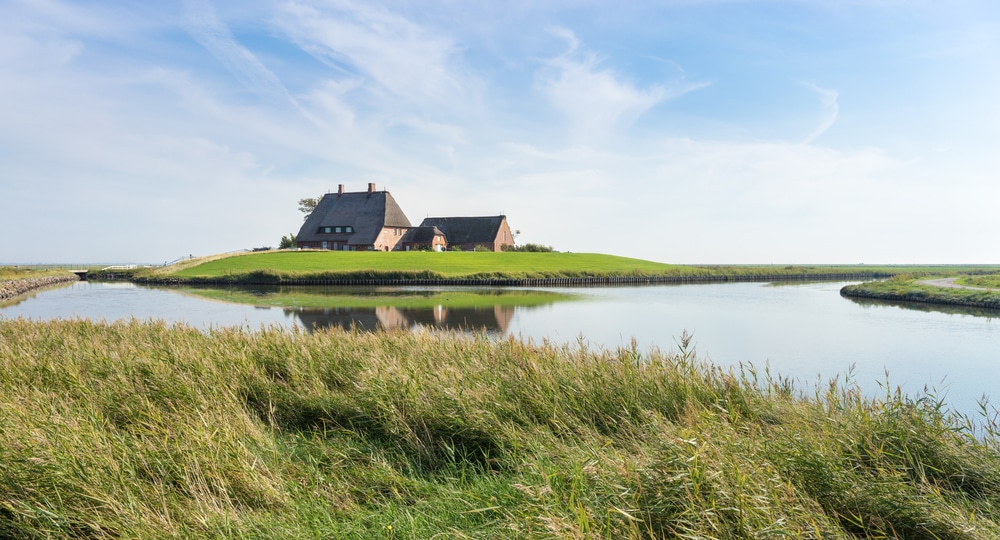Ten flat islands in the North Sea, which are flooded at high tide and are grouped in a circle around the island of Pellworm – these are the Halligen. They are called Gröde, Hooge, Langeneß, Nordstrandischmoor, Oland, Habel, Hamburger Hallig, Norderoog, Süderoog and Südfall. Five of the ten Halligen are permanently inhabited. The houses on the Halligen stand on artificially raised terps that protrude from the wild North Sea at high tide. There are no dikes. There is no fresh water on the Halligen, but an interesting flora adapted to the salty sea water.
Geography, formation and nature
Geologically, the Halligen are very young and once formed on silted or flooded marshland. In the past, they often changed shape, some disappeared and others, such as the Hamburg Hallig, merged with the mainland. Floods repeatedly caused changes to the coastline. Due to sediment deposits, some Halligen even enlarged. However, maps have only been available since 1700. The flora and fauna are represented by the Hallig lilac flower, the sea beach plantain, ringed geese and many other species.
Places of interest on the Halligen

The unpredictable forces of nature and the way they are dealt with probably attract most guests to the Halligen, but the Halligen also offer some cultural sights. The pretty Hallig churches in particular are definitely worth a visit. These are located on the Halligen Hooge, Oland, Langeneß and Gröde.
Among the museums on Langeneß are the “Captain Tadsen Museum” and the cozy “Friesenstube”. Highlights on the Hallig Hooge are the local history museum, an old Frisian living room with interesting finds and the so-called Königspesel, a Frisian parlour that vividly conveys the living culture of the seafarers with its faience.
In addition, the Mensch & Watt experience centre on the Hallig Hooge provides exciting insights into the diverse relationships between man and nature on the Halligen. Highlights are the tidal aquarium and the mudflat workshop.
In the storm surge cinema, visitors are shown a typical country underwater on a large screen. Langeneß has the exhibition room of the Wadden Sea Conservation Station on the Rixwarft, where visitors can get an idea of the nature and culture on the Halligen in two exhibitions and guided tours during the summer season. There is another exhibition room on the Peterswarft. Here, the plants of the salt marshes and the bird life are the focus. But the challenges for the Halligen due to climate change are also discussed.
The replica of a sailing cart and a post windmill on the Ketelswarft Captain Tadsen Museum also attract interested parties.
Wadden hikes
Various mudflat hikes are offered, including one from the mainland to Hallig Oland, another to Gröde and another from Hallig Hooge to Japsand. Usually a visit to a Hallig church and of course a terp is included in the program. The duration is six to seven hours, but shorter mudflat walks with a duration of about two hours are also on offer. A total of 3200 animal species live in the Wadden Sea, 250 of them in the salt marshes. There are over 60 species of fish in the water. Countless mussels, snails, small crabs and of course the famous lugworm can be observed during a mudflat hike. The experienced mudflat guides provide informative insights into the Wadden Sea ecosystem and have all kinds of stories and anecdotes in their luggage. For young and older guests alike, a mudflat hike is a highlight during a stay on the Halligen. Visitors’ favourites are seals and grey seals, which are mainly found on the offshore sandbanks.
Life on the Halligen

The Halligen have been continuously inhabited since the Viking Age. At that time, Frisians who came from the area of the mouth of the Rhine settled here. From the very beginning, the terps served as protection against flooding. On the upper floor, all houses have had their own shelter since the huge storm surge of 1962. Today, about 230 people live on the Halligen, mainly from tourism as the most important source of income. In addition, agriculture with its focus on livestock farming still plays a certain role.
A smaller part of the population works for coastal protection at the Office for Rural Areas of the State of Schleswig-Holstein. Individual people are employed as teachers and pastors. In addition, NABU and WWF maintain stations with employees on the Halligen.
For a long time, electricity was generated by windmills and generators, but until the 1960s it still happened that Hallig residents did not have secure access to electricity. In the meantime, there are power cables to the mainland that guarantee a continuous power supply.
For a long time, the inhabitants were dependent on the collection of rainwater in cisterns for the water supply. A distinction was made between service water for humans and for livestock. The latter was stored in a water pit at the highest point of the terp. Longer dry seasons or the salinization of drinking water were constantly in the room as dangers. Fresh water then only came to the Halligen by ship. Similar to electricity generation, water pipelines to the mainland have been built since the 1960s. The uninhabited Halligen, on the other hand, still have no fresh water pipe.
Since the 1990s, the Hallig residents have also had Internet access. In the meantime, efforts are being made to get a fiber optic connection. Modernity has found its way into the stormy island world. Smaller grocery stores are available on Hooge and Langeneß for daily shopping, otherwise food is delivered by ship. There are certain delivery days for this purpose.
Nursing stations are owned by the Halligen Hooge and Langeneß. Of course, Hallig schools are not missing either, even if the number of teachers and pupils remains very manageable. The relationship between teacher and student is very close, there are even school classes that consist of only one student. But the funding is all the better.
Coastal protection, flooding and the current situation
In 1825, the great Hallig flood swallowed up all but the Halligen, which still exist today. A large loss of land was the result. Due to Lahnungen and stone layers, the area of the Halligen is even increasing today. However, the heights of storm surges continue to rise, especially in times of climate change, and require regular adjustments. In this way, the terps were further raised and fortified. Together with the Hallig residents, all inhabited terps are to be raised. The North Frisian outer sands of Japsand, Norderoogsand and Süderoogsand also contribute to the protection of the Halligen. However, it is still called land under, especially in the winter months. Up to 20 times a year, the sea floods the Halligen. Last but not least, the floods promote natural growth and ensure salinity.
Festivals and traditions
The festivals and traditions on the Halligen include the Biike brennen, the ringed goose days and the traditional costume summer. The Biike brennen heralds the end of winter and, like everywhere else in northern Germany, is a great spectacle. They celebrate and drink together. The Brent Goose Days are all about nature conservation and bird watching, when huge flocks of Brent Geese stop off on the lush green Hallig meadows. At the Trachtensommer, more than twenty traditional costume groups from the Halligen and the mainland dance together on the meadow of the Hanswarft. In addition, the women serve culinary delicacies. The character of the festival remained very familiar. Other festivals on the Halligen are the museum market with an open day in the Hallig Museum on Hooge, the lock festival with sailing regatta and the winter market on Langeneß


